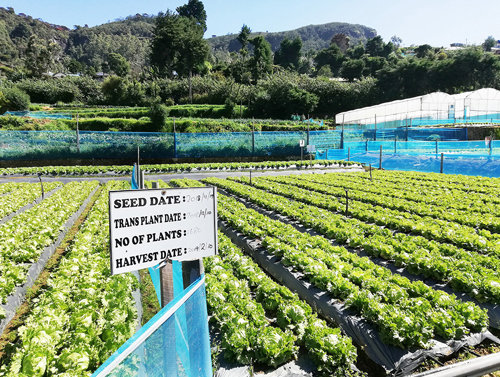Lazy crops and beyond
View(s):
File picture of an organised agriculture farm.
There are, what are called, ‘lazy crops’ in this country including many fruit and vegetable varieties, as many would testify. They are the crops that you can plant and forget, and then go for the harvest after a couple of months or years, depending on the type of the crop. In other words, you don’t need to do anything in between planting and harvesting!
Crop number one
The number one among the ‘lazy crops’ is coconut. If you have an acre of coconut land, even with lowest productivity levels you can pluck 15-20 coconuts from a tree, and your monthly income would be about Rs. 50,000 at the current market prices, according to my investigations. This Rs. 50,000 is just coming in every month and you don’t have to do anything to earn it – not even go to pluck the coconuts; the coconut trader in the locality knows the time to pluck them. He would come regularly with labourers to pluck and collect your coconuts, then load to his truck and take them away, after paying you.
In the villages in the country’s coconut triangle, there are different types of ownership trends: According to one type, the coconut lands are relatively bigger at 10 – 20 acres, owned by people who work and live in Colombo. The other type is the smaller plots of coconut lands, as small as 1 – 2 acres, owned by the villagers. Being, perhaps, the most preferred ‘lazy crop’ in the country, some of the owners of both types benefit.
Villagers can spend their time leisurely as there is a guaranteed regular income for their family. They are satisfied with their incomes unless they want to do something more in order to upgrade their living standards. Landowners from Colombo too don’t have to worry much about their coconut lands in the village; it doesn’t clash with their work and business in Colombo. They could go there once in a while for a weekend vacation, escaping the hectic urban life in Colombo.
Coconut beetles
It was interesting to listen to the old stories of one of my old friends, Raja – a retired public sector employee. He is from a village at a corner of the ‘coconut triangle’ of the country. Throughout the period of his employment in a government office in Colombo, he used to travel daily by the Maho office train. He was of the view that there is a precise distance between coconut trees; if this distance is shortened and more trees planted coconut productivity would go down and coconut trees might be prone to diseases and beetle attacks.
While explaining about coconut lands, Raja said: “Those days – I mean, about 50 years ago, one of our villagers had a job in a coconut estate while the landowner was living in Colombo. This man had to catch ‘coconut beetles’ by climbing the trees one by one and using a metal string with a hook. After showing the beetles to the watcher, he got his payment – one cent per beetle; he used to earn about one or two rupees a day.”
Raja continued: “He collected the beetles into bottles which were taken away to destroy them and throw into the river. It was a sinful act for him to kill the beetles and thus did not do so. After a drink in the evening he had to go home passing the coconut estate; he used to bring the beetles back along with him and release them again at the same coconut estate. The next day he catches them again and this way his daily income was secure.”
Fruits and vegetables
While fruit cultivation is not common in Sri Lanka, most of the fruits available are just grown in the home gardens without much effort. They are not commercial crops, although in seasons fruits come to the market without any sorting and grading – tender ones, mature ones, ripe ones and even rotten ones, all of them together. Fruit farms are a new concept, but they are still limited to a handful of fruit varieties such as banana and papaya.
Any producer who has gone beyond that is mostly a medium-scale or large-scale commercial producer; they are quite rare in Sri Lanka. Small farmers do not seem to have the required capacity and know-how in order to move into diversified fruit cultivation. By the way, even eating fruit as part of the daily food intake is still a luxury in Sri Lanka.
 Many of the fruit varieties may fall under the category of ‘lazy crops’ because they grow and bear fruit without much labout input. Unlike most of the Sri Lankan home garden fruits, vegetables usually grow and bear fruit within a shorter period – a couple of weeks or months. Many of the vegetables, therefore, need constant labour inputs throughout the process, but still there are some varieties such as pumpkin and cooking melon which fall under the category of lazy crops. This is because considerable labour inputs are required only on two occasions – planting and harvesting.
Many of the fruit varieties may fall under the category of ‘lazy crops’ because they grow and bear fruit without much labout input. Unlike most of the Sri Lankan home garden fruits, vegetables usually grow and bear fruit within a shorter period – a couple of weeks or months. Many of the vegetables, therefore, need constant labour inputs throughout the process, but still there are some varieties such as pumpkin and cooking melon which fall under the category of lazy crops. This is because considerable labour inputs are required only on two occasions – planting and harvesting.
Shrinking farm size
Majority of the farmers are small as they have small farm-holdings. According to the Census of Agriculture 2002, there are over 3.2 million farm-holdings in the non-estate sector, while 45 per cent of them are smaller than a quarter of an acre. The average farm size is 1.2 acres. The output such small-scale farms at a time need to be measured in, is no more than kilograms, which is inadequate to lift a farmer household above survival.
There are 2.1 million farmer households with 8.1 million people making up 40 per cent of the total number of households in the country. As population grows over time, they need more and more jobs in the non-agriculture sectors. As non-agriculture sectors have not been expanding enough the growing population gets locked up in the same less productive and non-rewarding agriculture sector.
When the agriculture output from the ‘small farm’ is not increasing above the ‘survival’ level, the vulnerability of the agriculture households is bigger too. A drought, a flood, a price fall, a bumper supply, a fertiliser price hike or anything as such can knock down the fragile living conditions of farmer households.
The matters get worse as farm size becomes smaller and smaller from generation to generation due to land fragmentation. With economic development, we should be able to observe land consolidation as developed countries in the world. However, in Sri Lanka what we have seen is its opposite – land fragmentation!
Survival strategies
When the survival based on agriculture is challenged as such, the farmers try to maximise output by using more and more agrochemicals. It is a confirmed fact that agrochemicals are used more in smaller farms than in large farms in the world. The reason is that it is the easier way to get few more kilograms of output.
Besides, it is a lucrative ground for politics too; you bring out various assistance programmes wasting even tax money – price ceilings, guaranteed prices, protection from imports, fertilizer subsidies, and many other! Nevertheless, the strategy has never worked so far. Farmers have never become rich by engaging in farming and agriculture has never generated tax revenue for the government.
After all, we might have to answer the question – what is the solution? The key to the solution is not in the agriculture sector. It is with urban development in which there should be industrial and service sector development. Industrial and service sector development will absorb the excess labour from the agriculture sector and allow for land consolidation in the agriculture sector. In this process, as it was the case in developed countries, even the agriculture sector will have a better future as a competitive business activity.
(The writer is a Professor of Economics at the University of Colombo and can be reached at sirimal@econ.cmb.ac.lk and follow on Twitter @SirimalAshoka).



